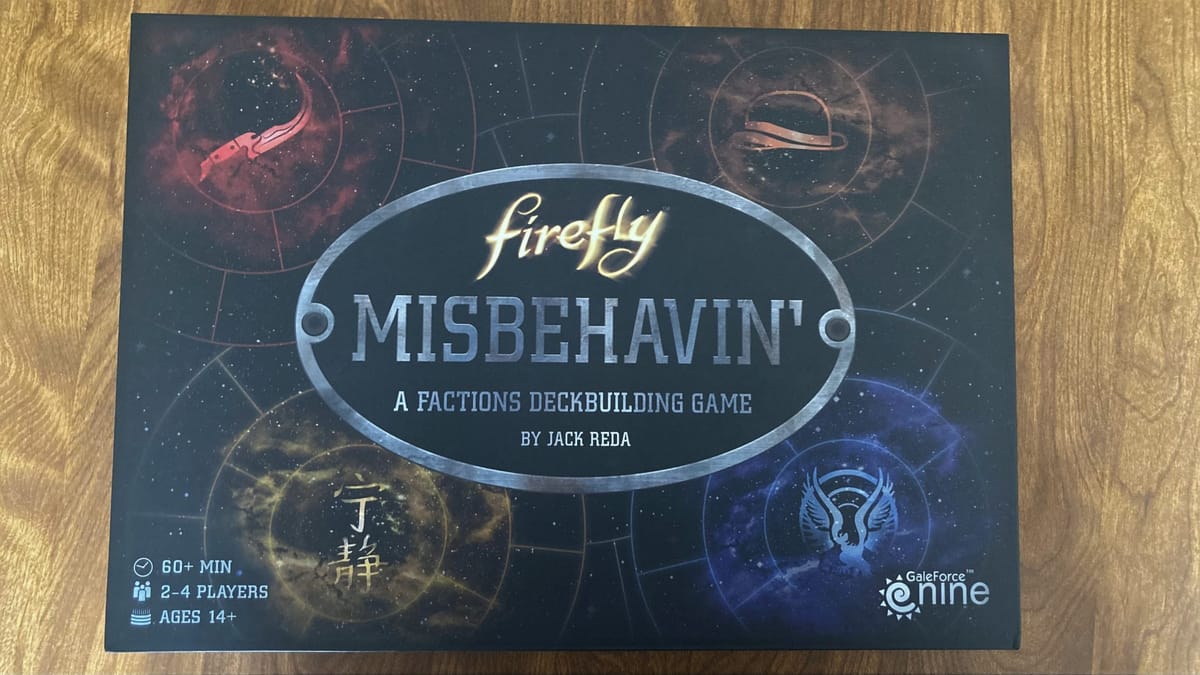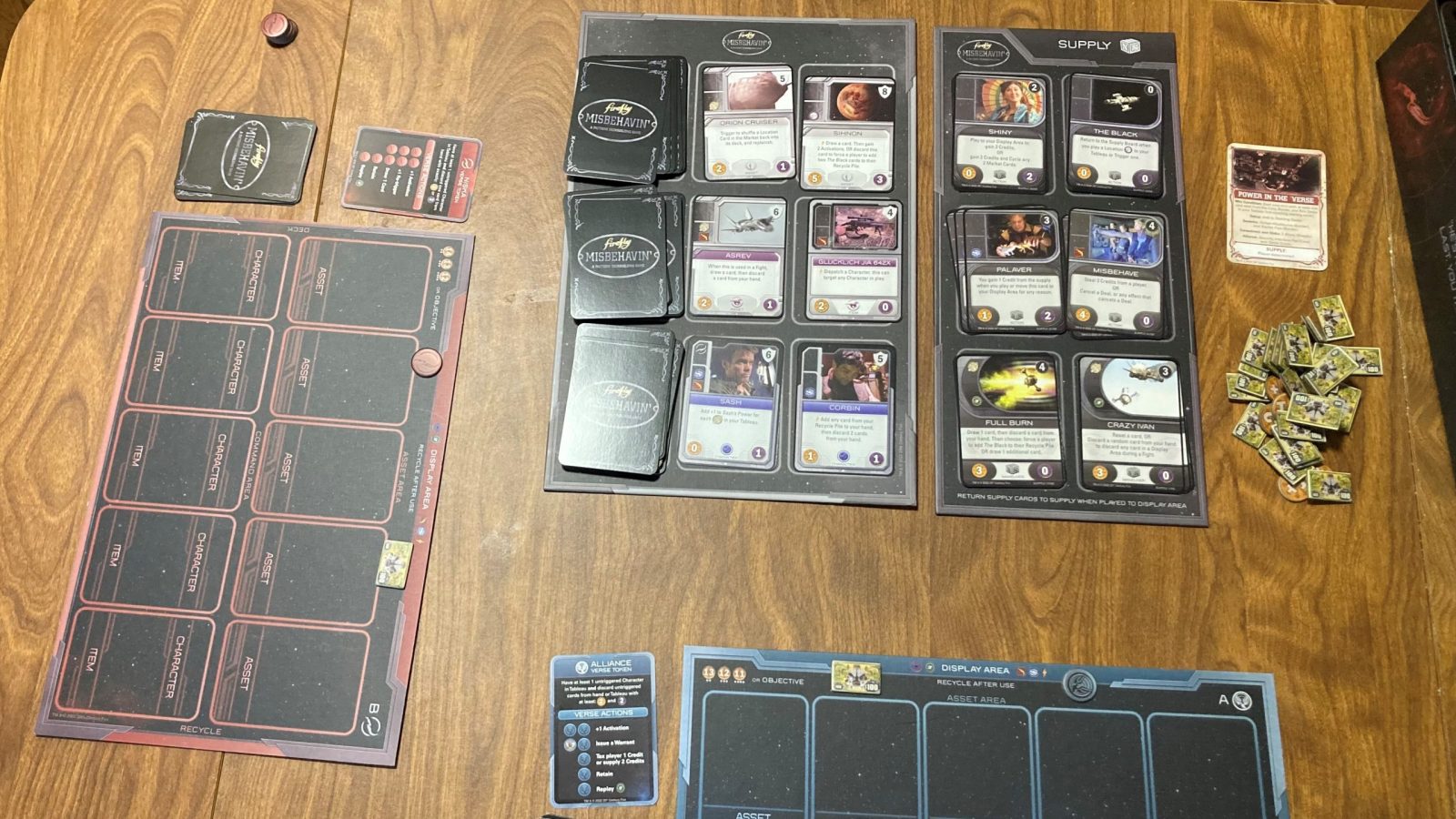
Firefly is a cult classic, a short-lived science fiction/western television series. It’s full of comedy, realistic relationships, and truly human characters. It’s also been adapted to some successful board games. Is this newest version successful?
Firefly: Misbehavin’ calls itself a “factions deckbuilding game,” and all the standard trappings of a deckbuilder are there. Each player starts off with a deck of 10 cards matching their chosen faction. There are cards that can be purchased with influence in a market and supply set up in the middle of the table.
What Firefly: Misbehavin’ adds to the mix is a full-time tableau, rather than just a play area. Each player has a tableau in front of them where they can play cards for semi-permanent powers and increase their power total. That power total is how players win in the basic game. It turns into a race, but you can sabotage your opponents through fights targeting specific cards in an opponent’s tableau.
However, this race for power does not feel thematic in a Firefly game. Rarely in the show are all the major factions attempting to reach the same goal. The crew of the Serenity are trying to get jobs, legal or not, to stay alive and keep the Serenity flying. The Alliance is in control and trying to weed out lawlessness (as defined by the Alliance) and maintain control of the system. The other two factions, Eavesdown (Badger’s group) and Nishka (run by the sadistic Adelai Nishka,) were criminal groups but operated very differently. So having all four groups racing for the most power feels a little odd, considering the Alliance had so much overarching power and the other groups tried to operate in the shadows with little intent to overthrow the Alliance.
The game does attempt to add more thematic elements through the introduction of Episodes. These cards add different win conditions and even setup conditions. These in some cases have asymmetric win conditions for the factions which feels more like the Firefly universe. However, these fail to address some of the core issues with the gameplay itself.
Deckbuilders as a whole are based around the premise of quickly adding cards to your hand that in turn allow you to accomplish more things. That can be doing damage to your opponents, giving you more purchasing power, or otherwise affecting the game state. You typically can do as much in your turn as your cards and influence/resources allow.
Firefly: Misbehavin’ does not allow that. It has a strict action economy and fairly expensive cards in the market that severely limits what you are able to do. This feels restrictive in ways that other deckbuilders I’ve played do not. The cheaper cards in the Supply area are one-time use cards that get returned to the Supply area after you use them, so you aren’t even really building your deck when you purchase them.

The action economy in the game also restricts what you can do on your turn. If you’re used to having a hand that gives you, say, five of the game’s resources, you can typically buy five resources worth of cards on your turn. Firefly: Misbehavin’ as a default only allows you to recruit (the game’s term for purchase) one card on your turn. You can purchase a second one by using your “Activation” to make a deal, but you need at least one card with the handshake symbol on it. You can then use a blend of cards and credits to purchase a card, but then you cannot play any cards to your tableau or trigger cards in your tableau for their powers. The advantage of a deal is that the card does go straight to your hand so you could get a card and in turn use it to get another card when recruiting.
There is some mitigation with some cards allowing you to take more activations or using ‘Verse tokens to take more actions. Each faction acquires these ‘Verse tokens differently, but it’s usually some combination of cards in your tableau and discarding cards from your hand. So if you want to acquire a ‘Verse token on your turn, it can stunt your ability to recruit or make a deal. However, each faction can use some tokens to take more actions on their turn, including playing a card to their tableau or picking a fight.
Fighting in Firefly: Misbehavin’ may not seem as important as acquiring cards at first, but it is one of the biggest keys to the game. Not only can you use the Fight action to prevent your opponent from winning by defeating a card in their tableau, you can even acquire that card if it’s something you desire and put it into your hand. Otherwise, you can force the defender to discard the card. Winning a Fight also gives you one of three bonuses whether you were the attacker or defender: You can draw a card from your deck, gain a credit from the supply, or gain a ‘Verse token. Honestly, the last option might be the most powerful due to the tokens’ powers.
For fans of the titular TV show, you’ll recognize plenty of characters and other trappings of Firefly in the cards. Each card has a screenshot from the show, so you’ll see familiar faces and locales throughout the game. Very few of the iconic one-liners are referenced, and they often feel pasted on rather than used properly. However, that’s really the only artistic design of the game. The tableaus are black with the accents in the specific faction’s colors. The market and supply boards are spartan and simply exist to show where to put the different stacks of cards.
If you like deckbuilding games, but feel like others you have tried have been too simple or fast paced for your methodical playing style, this game might be for you. After a couple of playthroughs and rereading the rules multiple times, there is a depth of strategy and complexity you won’t find in a lot of deckbuilders.
As a fan of deckbuilders like the new Star Wars Deckbuilding game and Clank in Space as well as a fan of Firefly itself, this game fell drastically short of expectations. Sometimes you may not care about the theme but the gameplay is so good it doesn’t matter and vice versa. At least for this Browncoat, Firefly: Misbehavin’ didn’t do either and failed as a Firefly game and as a deckbuilder.
Firefly: Misbehavin'
Bad
As a fan of deckbuilders like the new Star Wars Deckbuilding game and Clank in Space as well as a fan of Firefly itself, Firefly: Misbehavin' fell drastically short of expectations. Sometimes you may not care about the theme but the gameplay is so good it doesn't matter and vice versa. At least for this Browncoat, Firefly: Misbehavin’ didn’t do either and failed as a Firefly game and as a deckbuilder.
Pros
- The box art is fine
- The components are easy to organize
- The cards feature iconic characters and even scenes
Cons
- The gameplay feels extremely restrictive compared to most other deckbuilders
- The Firefly theme feels extremely tacked on as it does not match the standard win conditions or play mechanics, and it fails to capitalize on iconic moments of the series
- Cheapest cards to purchase are one-time use and due to the random nature of the marketplace, you can encounter situations where it feels like it takes forever to add quality cards to your deck
